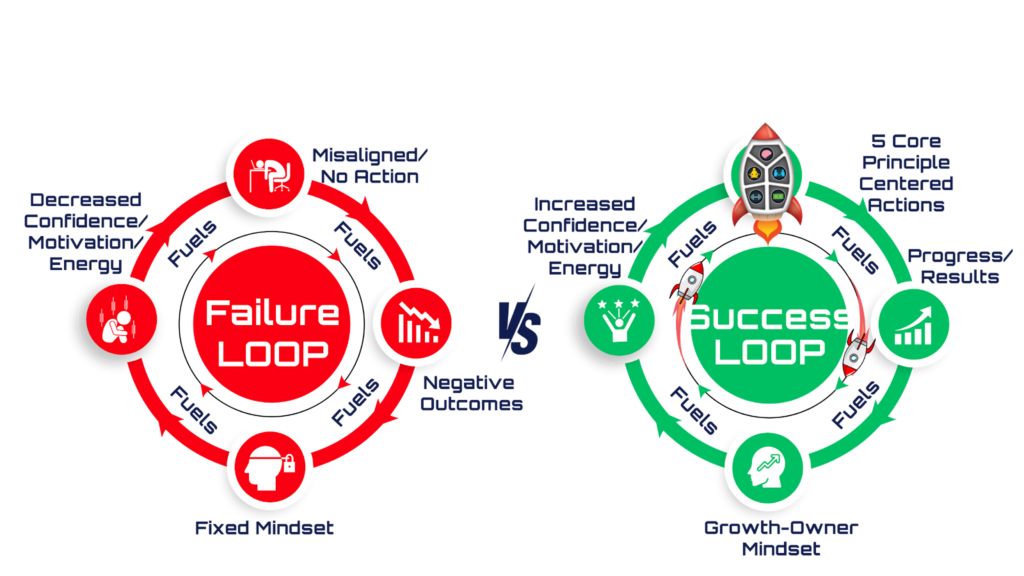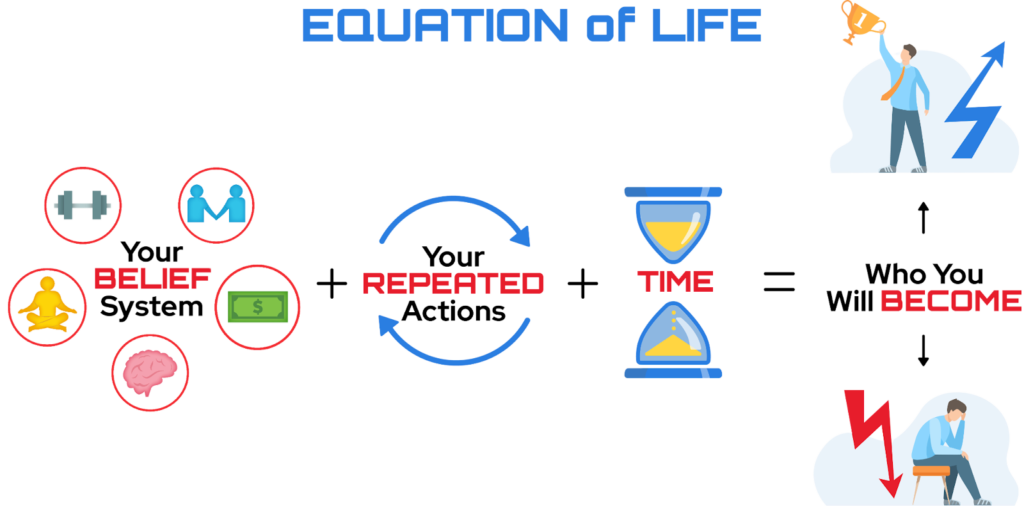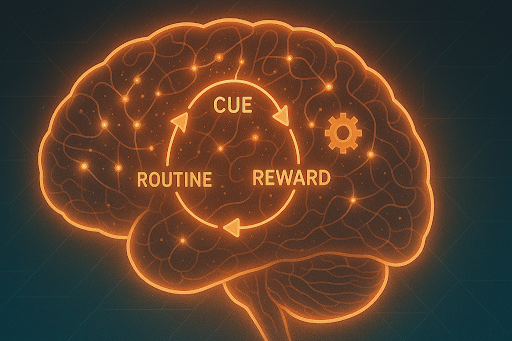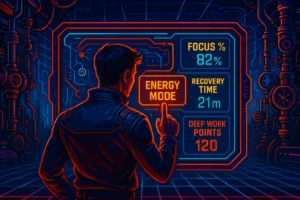Have you ever been driving somewhere but missed your turn and kept going? This is because your brain has already formed the habit of taking that turn and is attempting to conserve energy by taking the path of least resistance.
A behavior becomes a habit when it is repeated enough times to become automatic. Understanding the science of habits is fascinating and can be leveraged to transform your life. Like a curmudgeonly grandparent, the older habits are, the harder they are to break a bad habit.
Habits don’t care if they’re good or bad – they’ll do their thing over time via the law of compounding, forming grooves that become increasingly difficult to undo.
What are the most effective healthy habits to cultivate? How can you successfully break a bad habit that’s holding you back?
In this blog, you’ll discover:
- The science behind why breaking bad habits is so challenging
- Proven strategies to replace harmful patterns with healthy habits
- How to leverage technology to make habit formation automatic
- A framework for creating sustainable change across all core areas of life
- Practical steps to build momentum and launch yourself toward long-term success
The Science Behind Replacing Bad Habits with Healthy Habits
How Habits Form in the Brain
Habit formation is the process by which behaviors become automatic through repetition. Neuroscientists call this long-term potentiation—the strengthening of neural connections based on repeated activity. This is summed up by Hebb’s Law: “Neurons that fire together wire together.” The more you engage in a habit, the stronger and more efficient these neural pathways become.
Every habit—good or bad—follows a predictable four-step loop of cue, craving, response, and reward:
- Cue – The Trigger
- A time of day (waking up → checking phone)
- A location (walking into the kitchen → craving a snack)
- A feeling (stress → biting nails)
- Craving – The Motivation
- Your brain anticipates a reward, creating a craving.
- You don’t crave brushing your teeth—you crave the fresh feeling afterward.
- Response – The Action
- The behavior you take to satisfy the craving.
- The easier the response, the more likely it sticks.
- Reward – The Payoff
- If the reward is strong enough, your brain locks in the habit.
- The more often the loop runs, the stronger it gets.
Your brain uses this cue-craving-response-reward loop to conserve energy—relying on automatic behaviors instead of constantly making decisions. This is where habit triggers become crucial for understanding the process. Unfortunately, this reinforcement means bad habits stick just as easily as healthy habits.
What is the science behind habit formation? It’s essentially your brain creating shortcuts. Science-backed habits work because they optimize this natural tendency. When we understand how habits form on a neurological level, we can use that knowledge to break a bad habit and replace it with behaviors that better serve our goals.
The most effective approach isn’t to fight against this system but to work with it—leveraging the same mechanisms that created your bad habits to build healthy ones.
Read More: What is Keystone Habit
Why Breaking Bad Habits Feels So Challenging (And Why It’s Worth It)
Habits aren’t random; they’re solutions to what we perceive as problems or stress. Every time we face an unfamiliar situation, our brain has to solve a problem. When we stumble on a solution that provides relief—whether it’s scrolling social media to escape boredom or grabbing a sugary snack to deal with stress—our brain rewards us by reinforcing that behavior. The next time we face the same situation, we’re more likely to repeat the habit without thinking.
This reward system is one of the oldest survival mechanisms in our brain. In the past, it helped us find food, avoid danger, and form relationships by reinforcing behaviors that kept us alive. But today, the world has changed, and our instincts haven’t caught up. Instead of searching for berries, we’re clicking Buy Now. Instead of fleeing a predator, we’re binge-watching Netflix to avoid responsibilities.
The good news? You can’t fight science, but you CAN trick your brain into working for you instead of against you. The key is understanding your personal habit loops and learning how to swap in healthy alternatives that satisfy the same cravings without sabotaging your progress.

How Long Does It Take to Form a Habit? (Hint: It’s Not 21 Days)
You’ve probably heard the myth that habits take 21 or 30 days to form. But science says otherwise.
A 2024 University of South Australia study found that forming a habit can take anywhere from:
- 106 to 154 days on average for most healthy habits
- As little as 4 days for simple habits
- Up to 335 days for more complex behaviors
The time it takes to build a habit depends on several key factors:
- Complexity – Drinking a glass of water is easier to automate than daily strength training.
- Personal Importance – If you deeply value a habit, it sticks faster.
- Lifestyle Fit – If a habit seamlessly integrates into your existing routine, it forms quicker.
The good news? You can’t fight science, but you CAN trick your brain into working for you instead of against you. The key is understanding your personal habit loops and learning how to swap in healthy alternatives that satisfy the same cravings without sabotaging your progress.
Read More: How to Build Discipline and Consistency
The Five Core Areas of Life To Build Healthy Habits

If habits are the engine of change, the 5 Core Areas of Life are the blueprint for happiness. These five areas—Mindset, Career & Finance, Relationships, Physical Health, and Emotional & Mental Health—determine the trajectory of your life.
Think of them as the essential systems of your personal rocket ship, each requiring specific skill development and maintenance to function optimally. Each core is interconnected. A negative habit in one core can create a ripple effect across the others.
Thankfully, the same is true for healthy habits. Build momentum in one core, and it naturally strengthens the rest. This integrated approach to personal development represents the essence of holistic health practices.
Let’s examine how each core area drives your overall wellbeing:
Mindset Core: The Command Center

Your mindset determines how you approach challenges, failures, and opportunities. A growth-owner mindset fuels resilience, confidence, and action.
Key habit transformation: Replace negative self-talk with empowering affirmations, transforming the cue (encountering a challenge) into a growth opportunity rather than a threat.
Habits of healthy people in this core include morning gratitude practices and regular learning.
Read More: Abundance vs Scarcity Mindset
Career & Finance Core: Your Wealth Engine

Success in your career and finances comes from aligning your work with your strengths, managing money wisely, and continuously learning.
Key habit transformation: Transform reactive workdays into proactive ones with prioritization systems, changing the response to work pressure from stress to strategic action.
Simple lifestyle changes in this area might include automating savings or implementing a morning planning ritual.
Relationship Core: Your Crew

Strong relationships fuel happiness, success, and emotional stability. They provide both support and accountability.
Key habit transformation: Convert passive social media scrolling into active relationship building, replacing hollow digital rewards with meaningful connection.
Habits for good health in relationships include scheduling regular check-ins with loved ones and practicing active listening.
Read More: How to Heal from a Toxic Relationship
Physical Health Core: Your Structural Integrity

Your physical health fuels every other core. When you neglect your body, your energy, focus, and motivation suffer.
Key habit transformation: Restructure your environment to make movement inevitable, transforming the cue of fatigue from a trigger for rest to a trigger for rejuvenating activity.
Sustainable health habits include consistent sleep schedules, regular movement throughout the day, and proper hydration.
Read More: Stages of Burnout
Emotional & Mental Health Core: Your Shields and Blasters

Emotional resilience is your ability to handle stress, regulate emotions, and ensure you’re living life to its fullest.
Key habit transformation: Develop stress-management rituals, changing the craving for escape into a desire for emotional processing and growth.
Healthy habits to start might include meditation, journaling, or spending time in nature.
Think of each healthy habit as a thruster on your rocket. One alone may not be enough to achieve escape velocity, but together, well-developed habits across all five cores generate enough thrust to break free from the gravitational pull of your past limitations.
How to Replace Bad Habits With Healthy Habits
Get Your Habits Working FOR You
Now that you understand how habits form, it’s time to make that science work for you instead of against you. Our habits aren’t just behaviors—they’re the foundation of our daily experience, shaping our momentum in life. As Bruce Lee put it:
“If you love life, don’t waste time, for time is what life is made up of.”
No single habit will completely transform your life overnight. But compounding habits across all areas of life will (remember “The Equation Of Life” formula from above). Skip the gym one day? No big deal. But let that pattern repeat, and soon your energy plummets. Ignore your finances for a month? You might be fine. But let that habit compound, and suddenly you’re drowning in debt.
This is why identifying your “golden habits” is critical. These are high-impact behaviors that generate disproportionate positive effects across multiple areas of your life. Think of them as the main thrusters on your rocket—the habits that provide the greatest momentum with the least amount of effort.
Identity and Habit Change
But here’s the challenge: Your habits are tied to your identity, and identity is hard to change. We don’t just hold onto habits—we hold onto the beliefs that created them. Even when our habits aren’t serving us, admitting they need to change can feel like admitting we’ve been living the wrong way. That’s why deeply ingrained belief systems—formed in childhood around politics, religion, and success—are so hard to shift.
The good news? Your identity isn’t fixed. You don’t have to overhaul your entire life overnight to change. Small, consistent shifts in habits compound into identity shifts over time.
The Equation of Life: Your Blueprint for Change
My Equation of Life explains exactly how this works:
🧠 Your belief system (how you perceive and interact with the five core areas of life)
+
💪 Your repeated actions (the habits you build based on those beliefs)
+
⏳Time (allowing the law of compounding to kick in)
=
🚀 Who you will become!

If your belief system is broken, it’s reinforcing bad habit loops—habits that keep you stuck, drain your energy, and hold you back. The key to change is identifying these habits, replacing them with healthy alternatives, and applying momentum-building strategies to make them stick.
The Three Keys to Lasting Change
To get the E.O.L working for you to effectively break bad habits and replace them with healthy habits focus on these three essential elements:
- Awareness (Who you are): Understand your current patterns, triggers, and the underlying needs your habits are fulfilling. This requires honest self-assessment of which habits help and which hinder your progress.
- Vision (What you want): Create a clear picture of the person you want to become and the specific habits that person would have. This vision serves as your compass when motivation wanes.
- Action (How to get there): Implement proven strategies to make your new habits stick:
- Habit stacking: Attach new habits to existing ones (e.g., “After I brush my teeth, I will meditate for one minute”)
- Environment design: Make good habits obvious and bad habits invisible
- Start tiny: Begin with habits so small they’re almost impossible to fail
- Plan for obstacles: Create “if-then” strategies for common challenges
Creating sustainable health habits requires addressing all four components of the habit loop:
- Cue: Identify and modify the triggers that prompt your bad habits
- Make healthy cues obvious (leave running shoes by your bed)
- Make unhealthy cues invisible (keep junk food out of sight)
- Craving: Reframe how you think about the behavior
- Highlight the immediate benefits (“Exercise gives me energy” rather than “Exercise is good for me”)
- Make healthy habits attractive by bundling them with activities you enjoy
- Response: Reduce friction for good habits and increase it for bad ones
- Remove obstacles to healthy behaviors (prepare gym clothes the night before)
- Add friction to unhealthy behaviors (use website blockers during work hours)
- Reward: Make healthy habits immediately satisfying
- Create celebration rituals after completing habits
- Use habit tracking to provide visual evidence of progress
What are the most effective healthy habits? They’re the ones you’ll actually do consistently. Healthy eating habits work best when tailored to your preferences and lifestyle, making them sustainable rather than restrictive. Similarly, healthy sleep habits should align with your natural rhythms while supporting your daily energy needs.
The Key to Long-Term Success
Bad habits and healthy habits are built the exact same way. Your brain registers a reward for solving a problem or reducing stress, and it wants to repeat that behavior. The science of habit formation tells us the process is identical—it’s just the outcomes that differ.
The secret? Understanding which personalized mechanisms you need to tweak and levers you need to pull to build positive momentum building habits towards long-term wellness. 🚀 —and which ones keep you stuck when you’re trying to break a bad habit
The universal principle “We are what we repeatedly do. Excellence, then, is not an act but a habit” (often attributed to Aristotle) reminds us that our daily actions define our destiny. The habits you choose today will determine whether you stay grounded—or launch forward with unstoppable momentum toward
With the right system that combines behavioral science with personalized strategies, you can rewire your brain, replace bad habits with healthy ones, and start building unstoppable momentum in every aspect of your life. Modern tools and technology can help reduce friction in this process, making it easier than ever to identify and implement habits that align with your unique preferences and lifestyle.
🚀 Ready to Hack Your Habits Like a Pro?
You’ve just unlocked the science behind breaking a bad habit—now it’s time to put that knowledge into action!
🎯 Step 1: Discover Your Personal Blueprint for Success
Take our Core Values Quiz to see where you stand in the 5 Core Areas of Life—because self-improvement starts with self-awareness.
🔥 Step 2: Get Personalized Coaching to Build Momentum
Want to break free from failure habits and fast-track your success? Work with our expert coaching team to create a game plan tailored just for you.
🎮 Step 3: Gamify Your Growth with Our Habit Tracker
Make habit transformation simple, fun, and rewarding with the Weekly Habit Tracker App—because building momentum should feel like leveling up in the game of life.
🚀 OUR MISSION: To spark and sustain the momentum needed to continually level-up in the 5 Core Areas of Happiness by making habit transformation simple, fun, and ethically addictive.
Your future self is waiting. Are you ready to press start? 💡🔄💪






